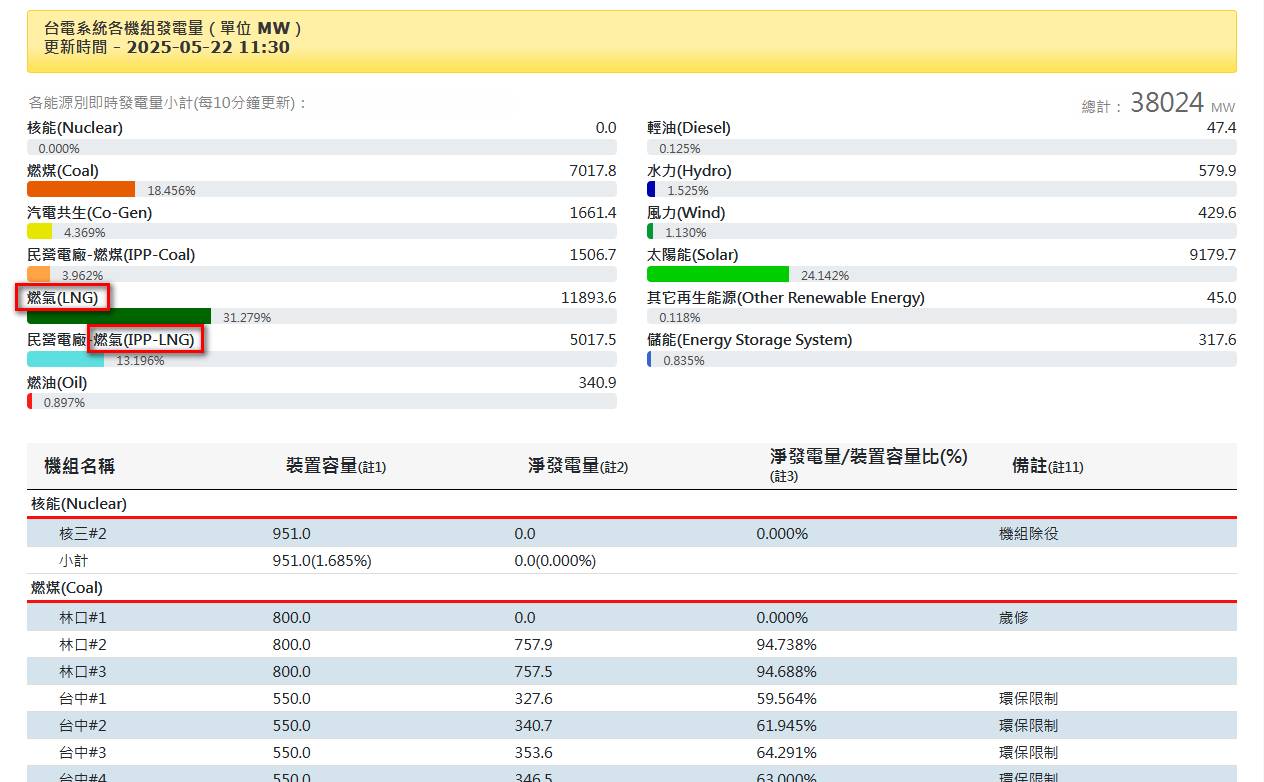看板Gossiping
: 餓死抬頭 是這樣的
: 最近核三終於停機了 而且跟美國買進的天然氣好像將要變成往年的3倍份量
: [新聞] 現有採購量3倍!美國官員宣布台灣每年買美國600噸天然氣
: #1e8npVgQ (Gossiping)
: 然後聽說興達燃煤電廠最近又重出江湖開始發電發熱了耶www
: [爆卦] 興達燃煤電廠又偷開機了
: #1eBelYVh (Gossiping)
: 一時興起就上網翻翻看關於LNG的消息 結果意外發現這篇康乃爾大學的校內新聞記事
: Liquefied natural gas carbon footprint is worse than coal
: https://news.cornell.edu/stories/2024/10/liquefied-natural-gas-carbon-footprint-worse-coal
: https://reurl.cc/nmAk4e
: 簡單說 這篇記事是在說明下面這篇期刊文章的研究結果
: The greenhouse gas footprint of liquefied natural gas (LNG) exported from the United States
: https://scijournals.onlinelibrary.wiley.com/doi/10.1002/ese3.1934
: https://reurl.cc/eMAqbW
: 研究結果大概可以整理成幾個要點來看
: *. 從2016年2月出口解禁以來,美國是全世界最大的LNG出口國家
: *. LNG從生產與液化處理,到後續的運輸配送,幾乎無可避免地會產生溫室氣體排放
: *. 前項所述LNG各階段的溫室氣體排放,除了二氧化碳之外,也有包含甲烷的排放
: *. 甲烷的全球暖化潛勢 (Global warming potential,縮寫為GWP),是二氧化碳的
: 80倍以上
: *. 研究結果顯示,最終燃燒LNG發電時的碳排放,只佔了LNG總碳排放量的約1/3,剩下
: 約2/3都是從LNG的生產/液化/輸送等過程所產生的
: *. 總的來說,把LNG從生產到消費過程全部列入考量時,LNG作為燃料的碳足跡,會比
: 使用煤炭還要多出33%
: 於是 我們又回到問卦的標題了
: 嗯 看起來標題的的問題已經被這篇paper回答完了 (LNG真的比煤炭還髒)
: 所以問卦的問題也不得不修改的更深入一點
: 「有沒有已知LNG比煤炭還骯髒 結果還有國家/政府/企業花大錢大量買進的八卦???」
: 哦對了 順便一提 現在台電的燃氣發電 到底燒的是哪種天然氣呢???
: 答案是:LNG
: XDDDDDDDDDDDDDDDDDDDDDDDDDDDDDDDDDDDDDDDDDDDDDDDD
: https://i.meee.com.tw/hLXWDZM.png
: ====
: 文末附上康乃爾大學校內新聞的對照翻譯作為偷懶用
: 有時間的話 建議直接看原文最準
: 真的很有時間的話 建議直接看paper然後帶大家導讀 @@
: ======================================================================
: Liquefied natural gas carbon footprint is worse than coal
: 液化天然氣的碳足跡比煤炭更糟糕
: Liquefied natural gas leaves a greenhouse gas footprint that is 33% worse
: than coal, when processing and shipping are taken into account, according to
: a new Cornell study.
: 根據一份新的康乃爾研究報告顯示,如果將液化天然氣 (以下簡稱LNG) 的製作處理與
: 運送過程也納入考量時,LNG的溫室氣體足跡比煤炭還要多出33%。
: “Natural gas and shale gas are all bad for the climate. Liquefied natural
: gas (LNG) is worse,” said Robert Howarth, author of the study and the David
: R. Atkinson Professor of Ecology and Environmental Biology in the College of
: Agriculture and Life Sciences. “LNG is made from shale gas, and to make it
: you must supercool it to liquid form and then transport it to market in large
: tankers. That takes energy.”
: "天然氣與頁岩氣對氣候都有不良影響。LNG比這兩者更糟糕。" 該篇研究報告的作者,
: 同時也是康乃爾大學農業與生科學院的生態學/環境生物學的「David R. Atkinson教授」
: Robert Howarth表示,"LNG是從頁岩氣加工製成的,要製造LNG必須要將頁岩氣(從氣態)
: 超冷卻至液態,然後使用大型油輪運送至消費市場。這些(步驟)都需要消耗能源。"
: The research, “The Greenhouse Gas Footprint of Liquefied Natural Gas (LNG)
: Exported from the United States,” published Oct. 3 in Energy Science &
: Engineering.
: 研究報告 「美國出口的液化天然氣 (LNG) 的溫室氣體足跡」 於 2024/10/03 發表於
: 「能源科學與工程」期刊。
: The emissions of methane and carbon dioxide released during LNG’s extraction,
: processing, transportation and storage account for approximately half of its
: total greenhouse gas footprint, Howarth said.
: Howarth指出,LNG的抽出、處理、運送、儲存過程中 (也就是說,用戶端還沒開始把LNG
: 拿來燃燒以前) 所造成的甲烷與二氧化碳排放量,大約佔了LNG的總合溫室氣體足跡的
: 一半左右。
: Over 20 years, the carbon footprint for LNG is one-third larger than coal,
: when analyzed using the measurement of global warming potential, which compares
: the atmospheric impact for different greenhouse gases. Even on a 100-year time
: scale – a more-forgiving scale than 20 years – the liquefied natural gas
: carbon footprint equals or still exceeds coal, Howarth said.
: Howarth表示,若以全球暖化潛勢的量測,也就是比較 (LNG與煤炭所產生的) 不同的
: 溫室氣體對大氣造成的影響進行分析時,在20年的評估期間內,LNG所造成的碳足跡會比
: 煤炭還要多出三分之一。縱使將評估期間長度延長至100年 - 這是比20年評估期間更加
: 寬容的尺度,LNG的碳足跡仍然大於或者等於煤炭。
: The findings have implications for LNG production in the U.S., which is the
: world’s largest exporter, after it lifted an export ban in 2016, according to
: the paper. Almost all of the increase in natural gas production since 2005 has
: been from shale gas. Howarth said the exported LNG is produced from shale in
: Texas and Louisiana.
: 根據報告內容,(前述的)研究發現與美國的LNG生產存在著關聯性。於2016年解除出口
: 禁令後,美國是世界上最大的LNG出口國家。從2005年以來的天然氣產量增加幾乎都是
: 來自頁岩氣。Howarth說,出口的LNG都是在德州與路易斯安那州以頁岩氣所製成。
: The liquefication process – where the extracted natural gas is cooled to
: minus 260 degrees Fahrenheit – makes LNG easier to transport on tanker ships.
: (天然氣的)液化處理 - 將抽出的天然氣冷卻至華氏零下260度F (大約等同於攝氏零下
: 162度C) - 此一過程讓油輪可以較為容易地運送LNG。
: But that mode of transportation comes at an environmental cost. The ships with
: two- or four-stroke engines that transport LNG have lower carbon dioxide
: emissions than steam-powered ships. But as those stroke-engine vessels burn
: LNG during storage and transportation, methane slips through as emitted
: exhaust gas, putting more into the atmosphere.
: 但是這樣的運送模式也伴隨著環境破壞的代價。採用二行程或者四行程引擎的LNG運送
: 船隻,所產生的二氧化碳排放量,是比採用蒸氣動力的船隻要少。但是這些採用二行程
: 或者四行程引擎的船隻,在LNG的儲存與運送過程中也會燃燒LNG (當作燃料),燃燒所
: 排放的廢氣中含有甲烷,最終 (這些甲烷) 也會被釋放到大氣中。
: Methane is more than 80 times more harmful to the atmosphere than carbon
: dioxide, so even small emissions can have a large climate impact, Howarth said.
: 「甲烷對於大氣所造成的損害程度是二氧化碳的80倍以上,因此即使只是小量的排放
: 也會對氣候造成很大的影響。」Howarth表示。
: That’s why, he said, the modern LNG tankers with two- and four-stroke engines
: have more greenhouse gas emissions than those tankers powered by steam.
: Regardless of better fuel efficiency and lower carbon dioxide emissions,
: methane still escapes in the tanker’s exhaust.
: 他 (Howarth) 說,這也就是為何,採用二行程與四行程引擎的LNG新式油輪,其溫室
: 氣體的排放量反而比蒸氣動力的舊式油輪要高的原因。縱使有著較佳的燃料效率以及
: 較低的二氧化碳排放量,甲烷仍然會從這些新式油輪的煙囪排出。
: And significant methane emissions occur in the natural gas liquefication
: process, a figure close to 8.8% of the total when using the global warming
: potential. Methane emissions from tankers vary from 3.9% to 8.1%, depending on
: the ship.
: 有相當程度的甲烷排放,發生在天然氣的液化處理階段。以全球暖化潛勢作為量測單位
: 時,液化處理階段的碳排放量佔了 (LNG的總碳排放量中) 約8.8%。來自油輪的甲烷排放
: 則佔了約3.9%至8.1%不等,視不同種類的油輪而定。(這邊建議看原paper的Table 3會
: 比較有感,簡單來說就是,實際燒LNG發電產生的碳排放量完全比不上LNG的生產液化
: 運輸過程的碳排放量)
: “Almost all the methane emissions occur upstream when you’re extracting the
: shale gas and liquefying it,” Howarth said. “This is all magnified just to
: get the liquefied natural gas to market.
: 「當你抽出頁岩氣並且將它液化處理時,幾乎所有的甲烷排放都是來自 (LNG生產流程的)
: 上游,」Howarth說,「這一切都被放大了,就只是為了將LNG送到市場上。」
: “So liquefied natural gas will always have a bigger climate footprint than
: the natural gas, no matter what the assumptions of being a bridge fuel are,”
: Howarth said. “It still ends up substantially worse than coal.”
: 「所以,LNG的氣候足跡總是會比普通的天然氣來得更大,即使在前提上將之視為一種
: 中繼能源,」Howarth說,「它 (LNG) 的表現在實質上還是比煤炭要糟糕得多。」
: The research was supported by a grant from the Park Foundation. Howarth is a
: fellow at the Cornell Atkinson Center for Sustainability.
: 此研究是由Park基金會的補助金所援助。Howarth是康乃爾Atkinson可持續性中心的
: 研究員。
: ======================================================================
一個很基本的問題
天然氣為什麼天然
原因就是氣
你把氣體的東西搞成液體
這本身就違反天然原則
舉個例反例就是煤炭
從頭到尾都是固體
沒有任何變化,這就是天然好嗎
天然氣比煤炭還好
僅限於台灣本身自產天然氣自己用
或是鄰國產天然氣拉管子到台灣
其他的情況
不建議台灣使用天然氣發電
--
※ 批踢踢實業坊(ptt.cc), 來自: 27.240.185.13 (臺灣)※ 文章網址: https://www.ptt.cc/bbs/Gossiping/M.1747893033.A.7B0.html
→ wintxa: = = 114.42.210.118 05/22 13:52
→ wintxa: 為什麼液化你有去查過嗎= = 114.42.210.118 05/22 13:53
→ vdml: -163度難道會天然達成嗎 60.248.143.146 05/22 13:56

